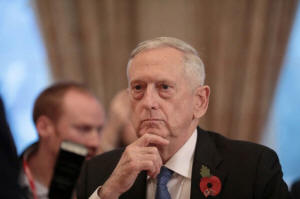|
As
U.S.-backed and Russian-backed forces battle to retake the
remaining pockets of Islamic State-held terrain, Mattis said the
U.S. military's longer-term objective would be to prevent the
return of an "ISIS 2.0."
"The enemy hasn't declared that they're done with the area yet,
so we'll keep fighting as long as they want to fight," Mattis
said, speaking to reporters at the Pentagon about the future of
U.S. operations in Syria.
He also stressed the importance of longer-term peace efforts,
suggesting U.S. forces aimed to help set the conditions of a
diplomatic solution in Syria, now in its seventh year of civil
war.
"We're not just going to walk away right now before the Geneva
process has traction," he added.
U.S. President Donald Trump and Russian President Vladimir Putin
affirmed joint efforts to stabilize Syria as its civil war
wanes, including with the expansion of a July 7 truce in the
southwestern triangle bordering Israel and Jordan.
Mattis said he believed the southwestern zone was working, and
spoke hopefully about additional areas in the future that might
allow for more refugees to return home.
"You keep broadening them. Try to (demilitarize) one area then
(demilitarize) another and just keep it going, try to do the
things that will allow people to return to their homes," he told
reporters at the Pentagon.
He declined to enter into specifics about any future zones.
Russia, which has a long-term military garrison in Syria, has
said it wants foreign forces to quit the country eventually.
Turkey said on Monday the United States had 13 bases in Syria
and Russia had five. The U.S-backed Syrian YPG Kurdish militia
has said Washington has established seven military bases in
areas of northern Syria.
The U.S.-led coalition says it does not discuss the location of
its forces.
One key aim for Washington is to limit Iranian influence in
Syria and Iraq, which expanded during the war with Islamic
State.
(Reporting by Phil Stewart; Editing by Peter Cooney)
[© 2017 Thomson Reuters. All rights
reserved.] Copyright 2017 Reuters. All rights reserved. This material may not be published,
broadcast, rewritten or redistributed.
 |
|






